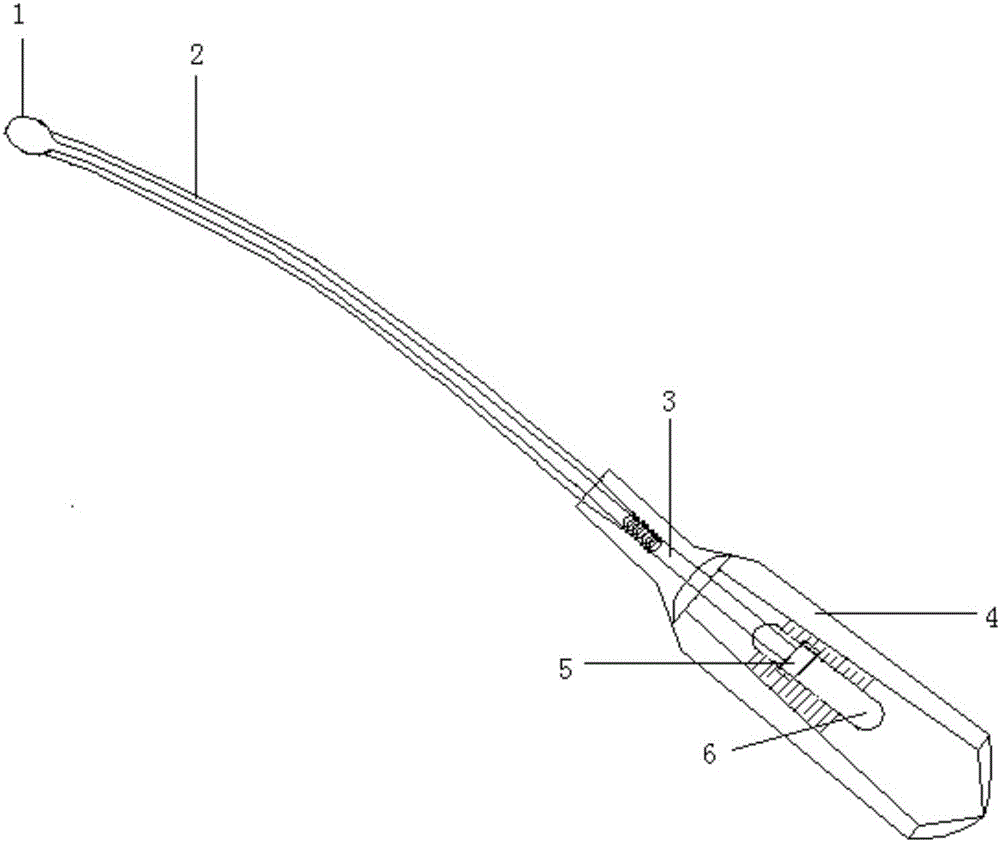[0002] As a common
surgical instrument in gynecology, curettes are widely used in gynecological diagnostic curettage and
obstetrics and gynecology abortion operations. Currently, the curettes commonly used in hospitals are divided into three types: large, medium and small according to the size of the curette head and the length of the curette neck. Model, large curette with long
diameter and wide ring is used for
uterine curettage after
childbirth or induced labor in obstetrics, while small and medium-sized curettes are mostly used in gynecological diagnostic curettage and early
pregnancy abortion operations; the normal human uterus is in an inverted
pear shape as a whole , the capacity of the
uterine cavity is about 5ml. Under
pregnancy and abnormal physiological conditions, the size of the uterine cavity will increase accordingly. In the process of abortion or dilatation and curettage, the uterus will shrink due to
muscle contraction as the operation progresses. At the same time, the
cervix will also be narrowed accordingly. At this time, it is necessary to replace the curette with a small size according to the size of the uterine cavity and the
stenosis of the
cervix to adapt to the changing uterus. Therefore, the degree of fit between the size of the curette and the uterus is the key to the success of the curettage operation. The key point is that if the uterine cavity is large and there are more substances in the cavity, and the curette used is small, it needs to be scraped bit by bit, so that the
operation time will be prolonged accordingly; if the uterine cavity is small and the
cervix is narrow, and the curette used If the curette is large, the cervix needs to be bluntly dilated before the head of the curette enters the uterine cavity, and the curettage will cause damage to the inner wall of the uterine cavity due to the larger curette, and even penetrate the inner wall of the uterus to cause uterine perforation; The curette used has the following defects: First, the size of the curette head is fixed. In order to be able to enter the uterine cavity for operation, the operation of dilating the cervix is usually performed first for patients with a tight cervix, which often causes damage to the cervix of the patient. Secondly, the curvature of the curette is not enough, it is difficult to reach the fundus of the uterus, and it is easy to cause
tissue residue in the uterine cavity during the curettage process; thirdly, there is no clear scale mark on the curette, and the doctor completely relies on the
visual distance to perceive the curette during the curettage operation Into the depth of the uterine cavity, the accuracy is poor, and the risk of uterine perforation is high
[0003] In recent years, some doctors have made corresponding improvements to the traditional curette. For example, the hollow oval ring at the head end of the curette is designed in the shape of a spoon, which is conducive to the scraped tissue being pushed out of the uterine cavity more conveniently, and will not be affected by scraping. The hollow part at the end of the spoon is scattered in the uterine cavity, causing tissue residues. However, this improvement is only a change in shape, and the size of the curette cannot be adjusted at will. During the operation, the curette needs to be replaced according to the suitability of the size and model. It causes a waste of
operation time and increases the chance of infection during the operation; considering the curvature of the uterine cavity, some physicians design the head of the curette as a curette that can adjust the degree of curvature, and pass the curette head and the curette
handle through the curette neck Connected together, the curette neck and the curette handle are both hollow structures, and a movable joint is set between the curette neck and the curette handle, and a curette head adjustment knob is arranged on the curette handle, and the curette head adjustment knob It is connected with one end of the traction
rope, and the other end of the traction
rope passes through the movable joint and the neck of the curette and is fixed on the curette head. The bending degree of the curette head is controlled by adjusting the knob, so that the curette can fit the uterine cavity more Reduce
tissue residue during curettage, but the adjustment knob in this design is more mobile, the operation is not strong, and the problem of adjusting the size of the curette head is not considered; therefore, the present invention designs a new adjustable gynecological Use the uterine curette to adjust the overall structure of the curette, so that the size and curvature of the curette head can be adjusted accurately, with a scale icon to accurately control the depth of the curette into the uterine cavity, which is convenient for accurate and
safe operation of curettage;
Chinese patent document CN202342156U is the closest prior art of the present invention
 Login to View More
Login to View More  Login to View More
Login to View More 

